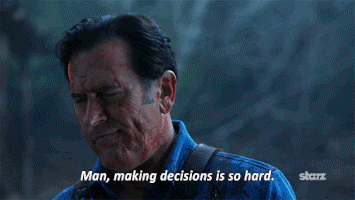— February 5, 2019
You’re a business owner. You’ve got a growing team working for you. It’s Monday morning and you’ve got your entire day planned.
You sit down at your desk and boom an email comes in. It’s Karen from the accounts team with an IT problem. Next, you get a Slack message from Todd about an HR decision that needs to be made. An hour later, Donna drops by your desk because she needs sign-off on a campaign. Before you know it it’s lunch and your To-Do list remains untouched. You haven’t even had a coffee yet.
You had it all planned out, but your plan to get shit done was overrun by a lineup of minor requests, approvals, and decisions.
Does this sound familiar?
We experienced this at Stryve. The account team had to come to the Managing Partners for sign-off and it created a bottleneck for both sides. The account team had to wait for the go-ahead while Ryan and I lost the time we needed to handle our own work.
For example, back when we moved to Catalyst, one of our team members was tasked with finding a new couch for the reception area. They knew the style we were going for, they researched all the options, and they knew the budget. They did all the prep work and were more than capable of pulling the trigger. However, with our decision-making setup, they needed to wait for approval from the higher-ups. In short, they were responsible but not accountable for the decision.
We realized this system of decision making wasn’t sustainable and we needed to change. So, Ryan and I decided that we didn’t need to be a part of every decision. Yes, even the “important” ones.

Important Reversible Decisions vs. Important Irreversible Decisions
In order to remove the decision-making bottleneck, we needed to know the difference between important reversible decisions and important “not easy to reverse” decisions. Take the couch, for example, we needed it but it wasn’t important. Sure, it would be the first thing people see when they walk in. Prospective clients would sit on it while they wait for meetings. We’d want them to be comfortable… Could couch comfort be the difference between landing a client and not landing a client? Wait, what if the couch is important! Maybe the couch…
No.
Stop it.
The couch is not important.
Your hand can’t be in everything. The couch isn’t going to affect the bottom line. It isn’t going to generate business or influence productivity. At the end of the day, even if the couch was important, it can be returned. It is a reversible decision, one that you can afford to give up.
On the flip side, an important irreversible decision would be the decision to move office buildings or switch your project management software from Trello to JIRA. These types of tasks are complicated, difficult to reverse, and tied to the success of your organization. These are the important decisions you need to be involved in.
As business owners, we tend to get caught up in both types of decisions and as a result, slow down the very team we’re looking to improve. Dividing decisions into these two groups will help you tighten up feedback loops and make time for what’s really important. For the decisions that don’t make the cut, you’ll empower your team by giving them both responsibility and accountability. If something goes wrong, they’ll fix it, learn from it, and be better for it.

Once we established this process, we created leaders for our functional areas and accountability check-ins
In order to remove our decision-making bottleneck, we delineated the following functional areas in our business:
- Company strategy
- Business development
- Accounting & Finance
- Operations
- HR
- Marketing
- Innovation
Remember Karen, Todd, and Donna from the beginning of the blog? We made them the functional area leaders of Operations, HR and Marketing, respectively, while Ryan and I take care of strategy, business development, innovation and accounting & finance. Once the strategy was set, every leader presented a 2019 plan for their functional area with reference to how the plan aligned with company goals. Plans were complete with their own objectives along with the tactics needed to meet them.
With the approval of both Managing Partners, it’s up the functional area leader to make things happen. This eliminates the need for approval on ‘important reversible’ decisions and relieves the functional area of bottlenecks. In order to create accountability (not just responsibility), we scheduled quarterly check-ins for each leader, tying success to raises and bonuses each year.
In order to grow and take your founder-led organization to the next level, you need to remove yourself as the decision-making bottleneck. This worked for us and we hope it will work for you too.
Business & Finance Articles on Business 2 Community
(33)






